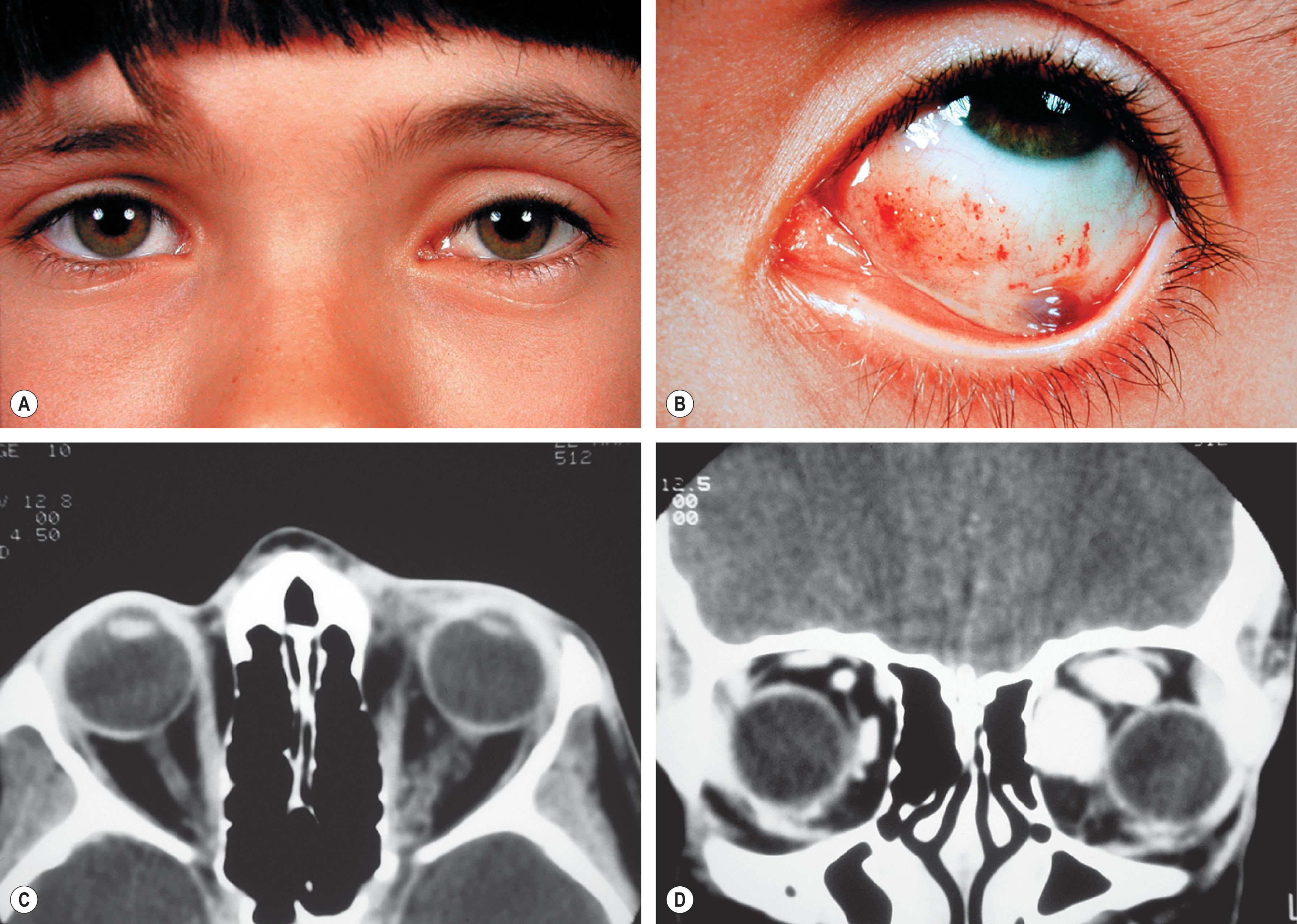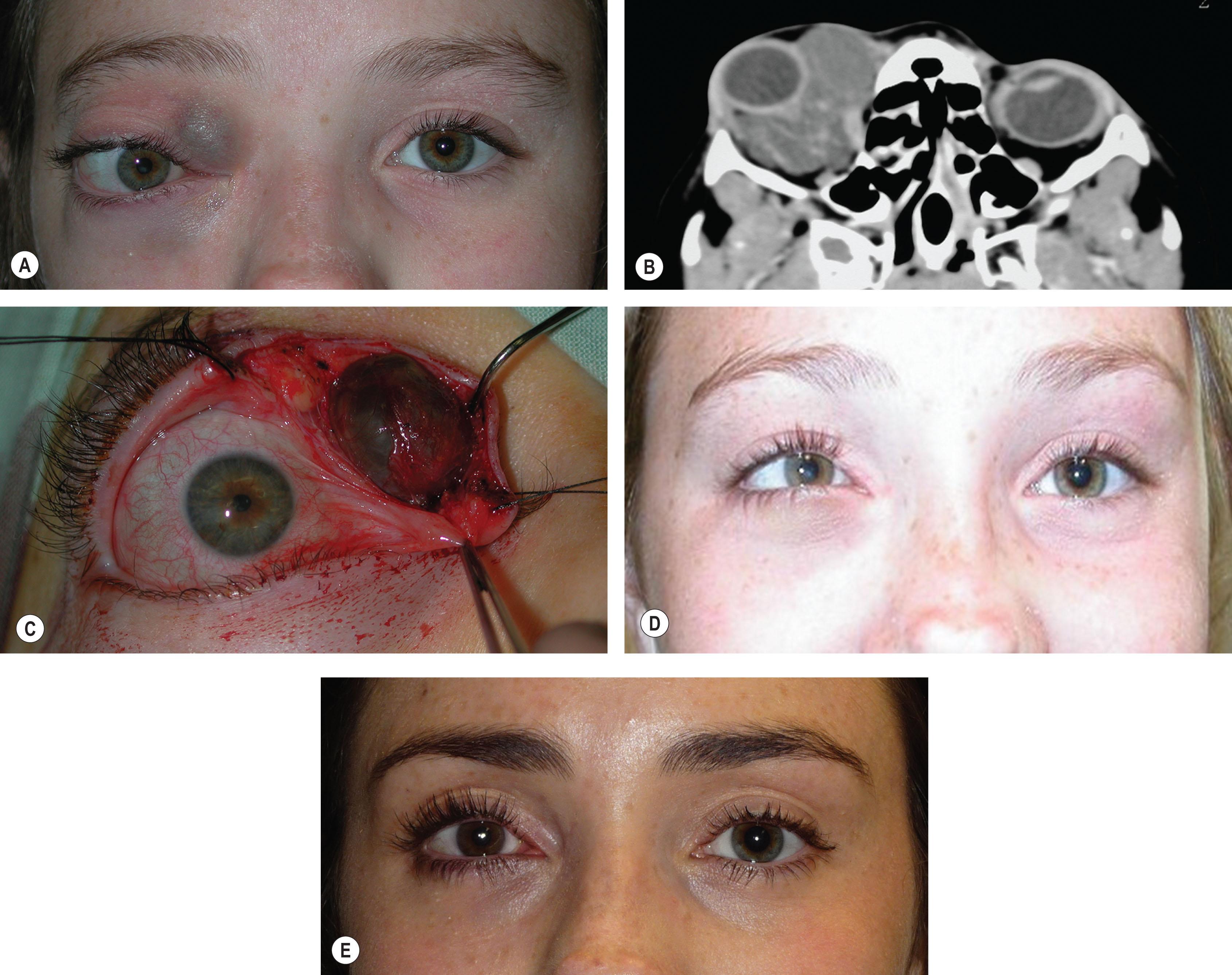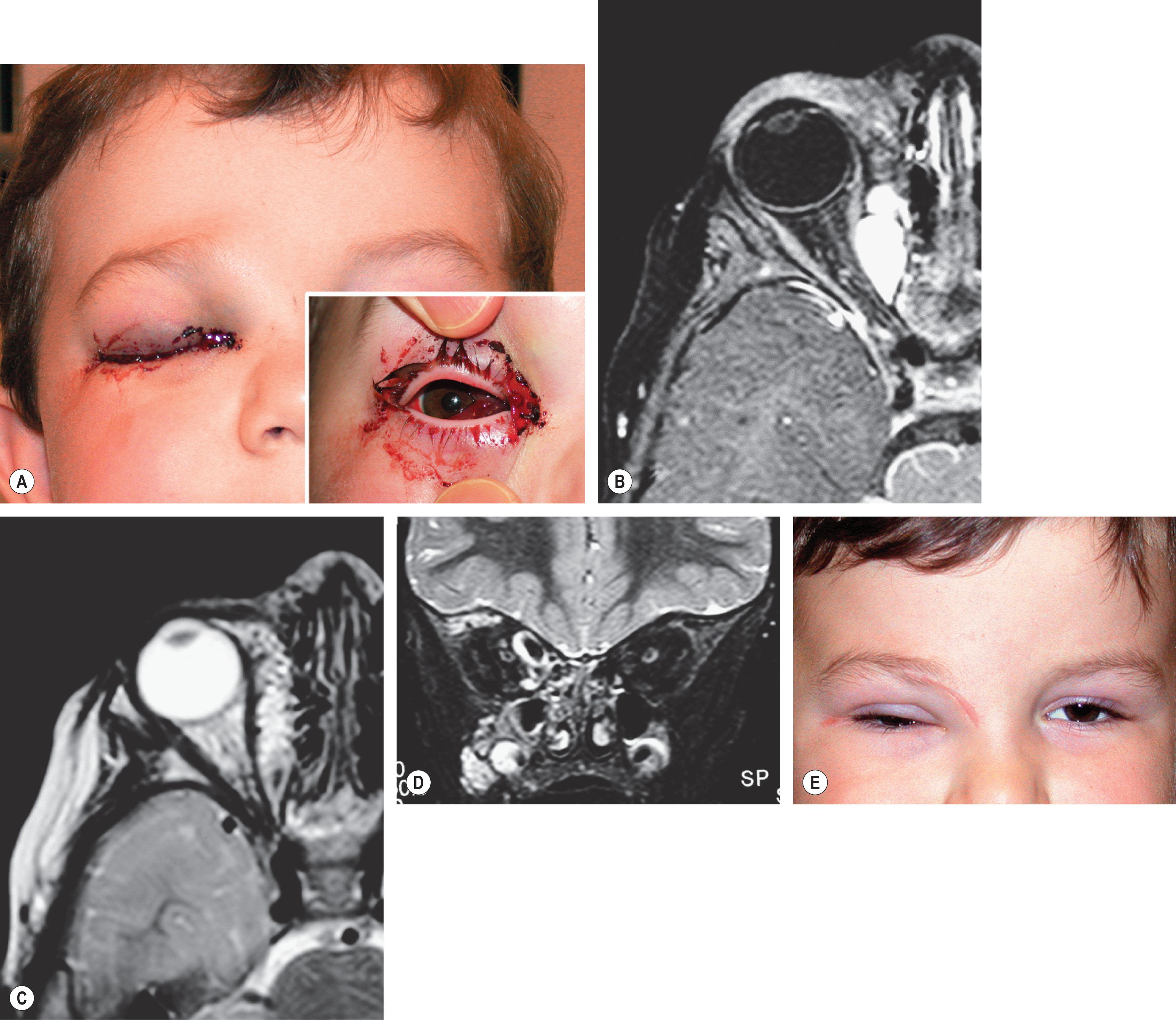Physical Address
304 North Cardinal St.
Dorchester Center, MA 02124
The vascular element of the orbit is an important source of disease in childhood with the potential to cause visual loss. For years, the names and nature of the various vascular anomalies which may affect the orbit were the subject of debate. The creation of the International Society for the Study of Vascular Anomalies (ISSVA), encompassing several relevant specialties, has helped to resolve these issues. Their classification and nomenclature is simple and comprehensive ( Table 20.1 ). The ISSVA website also lists known gene defects associated with these lesions.
| Vascular anomalies | ||||
|---|---|---|---|---|
| Vascular tumors | Vascular malformations | |||
| Simple | Combined b | Of major vessels | Associated with other anomalies | |
|
|
|
||
a Full classification available at https://www.issva.org/classification .
b Defined as two or more vascular malformations found in one lesion.
Vascular anomalies are broadly divided into malformations and tumors. The malformations are classified according to the type of vessel(s) involved (capillary, lymphatic, venous, and arterial) and many present in childhood. The most common are: (1) lymphatic-venous malformations (LVMs), sometimes called lymphangiomas. These very occasionally present in early childhood and are complicated by bouts of hemorrhage and progressive enlargement. (2) Venous malformations (VMs), sometimes referred to as orbital varices; and (3) arteriovenous malformations (AVMs). VMs and AVMs primarily present in the second and third decades.
Orbital tumors arising from the vascular component are common but fortunately usually benign; Infantile hemangiomas (capillary hemangiomas) are the most common orbital tumors of childhood, characterized by rapid growth during the first year of life and subsequent regression over the next several years. Rarer tumors such as hemangiopericytoma/solitary fibrous tumors may occur in the orbit.
Vascular malformations are now classified by the International Society for the Study of Vascular Anomalies (ISSVA) according to the type of vessel involved (capillary, lymphatic, venous, arterial) and may involve just one vessel type (simple) or combinations ( Table 20.1 ). The orbit and ocular adnexa are common sites of involvement and many of these patients present in infancy and childhood. A further useful clinical classification uses flow characteristics or hemodynamics (no flow, venous flow, arterial flow) of the lesion to help guide management. Within lymphatic malformations there may be micro- or macrocystic or mixed forms, and venous malformations may be distensible (increase in volume with Valsalva) or non-distensible. Lesions with an arterial component include arteriovenous malformations (AVM) and arteriovenous fistulae (AVF). Combined lesions are most often lymphatic-venous malformations (LVM).
These usually present in childhood and are often difficult to manage. They may enlarge gradually, but their expansion can be sudden from hemorrhage into the lesion. Unlike infantile hemangiomas, they do not undergo spontaneous regression. Deeply situated lesions are difficult to excise; their margins are poorly defined and they arborize widely throughout the orbit.
LVMs account for a small proportion of orbital tumors. In one-third of cases, the lesion is apparent at birth or within the first weeks of life, and over three-quarters of patients present in the first decade of life. A female preponderance (ratio 2–3 : 1) has been reported.
Their occurrence within the orbit is puzzling in view of the absence of lymphatic drainage from the retroseptal tissues. It has been suggested that LVMs arise from primitive vascular elements within the orbit. However, ultrastructural analysis and immunochemistry have identified lymphatic endothelium in orbital LVMs. They do not appear to grow by cellular proliferation but instead the full extent of the malformation is present at birth, insinuating itself within the normal orbital tissues. Since the vascular channels have characteristics of both lymphatic and venous vessels, the histologic differentiation of LVMs from orbital varices (pure venous malformations) has been a source of debate. Hemodynamically, LVMs and orbital varices (VMs) are part of a continuum of venous-derived lesions, differentiated according to the presence or lack of connection to the venous system. Whereas varices are connected, and therefore expand with Valsalva maneuver or supine posture, LVMs are isolated and do not. The extremes of the spectrum can be differentiated histopathologically; the LVM element has distinctive electron microscopic features. The pathogenesis of these lesions relates to the lack of blood flow and the tendency for sludging, neovascularization, hemorrhage with recurrent inflammatory episodes, and the formation of isolated “chocolate cysts.”
Histopathologically, they consist of diaphanous, serous fluid-filled channels lined by endothelium. These have characteristics of true lymphatic channels as well as areas of dysplastic channels. Lymphoid follicles are often present in the stromal components.
The clinical features of LVMs vary with the extent and depth of orbital involvement.
Isolated superficial involvement is comparatively rare and consists of multiple conjunctival cysts filled with clear or xanthochromic fluid, or a subcutaneous bluish cystic swelling of the eyelid. The latter may transilluminate and present with an abrupt localized change in color due to hemorrhage into a pre-existing lesion. Hemorrhage into superficial lesions may result in the striking appearance of blood menisci within the conjunctival cysts ( Fig. 20.1 ). These may be accompanied by recurrent subconjunctival hemorrhage and lid ecchymosis. Superficial LVMs are easily accessible and, if unsightly and localized, may be excised with good results.

The hallmark of deeply situated orbital LVMs is proptosis ( Figs. 20.2 and 20.3 ). Deep LVMs may present with gradually increasing proptosis, with or without ptosis. The orbit is often enlarged. Clues to the diagnosis may include changes seen in the conjunctiva or eyelids ( Figs. 20.4 and 20.5 ). An increase with upper respiratory tract infections and other generalized inflammatory states has been attributed to lymphoid activity within the lesion. Deep hemorrhage results in proptosis, sometimes associated with compressive optic neuropathy. Combined lesions may be large enough to simultaneously involve every orbital space, producing gross proptosis and facial deformity, some from extension through the superior orbital fissure. Non-contiguous intracranial vascular abnormalities may occur. Since the latter are at risk of bleeding, brain imaging is indicated in patients with orbital LVMs.




The most typical presentation is with sudden proptosis resulting from hemorrhage into a hitherto-unsuspected lesion. The differential diagnoses include other causes of rapidly increasing proptosis such as rhabdomyosarcoma (see Chapter 22 ), neuroblastoma (see Chapter 24 ), etc. Examination of the nasal and palatal mucosa may be helpful if it reveals mixed clear fluid and blood-filled blebs of widespread LVMs (see Fig. 20.4 ). Optic nerve compression may occur with rapidly expanding blood-filled “chocolate cysts” with decreased visual acuity and disc swelling. It is an indication for urgent orbital intervention to decompress or excise the lesion.
Computed tomography (CT) scanning shows a soft tissue density mass with poorly defined margins and non-homogeneous enhancement after injection of contrast medium. Bony destruction is absent but large lesions can result in smooth enlargement of the orbit. The presence of a cystic component helps differentiate LVMs from infantile hemangiomas. Calcified thrombosis within venous components (phleboliths) may be seen on plain X-ray or CT scans. Since hemoglobin has paramagnetic qualities that change as blood denatures, blood-containing “chocolate cysts” are well visualized by MRI scanning ( Fig. 20.6 ). The age of intralesional hemorrhages can be assessed since oxyhemoglobin in fresh hemorrhage is hypointense on T1- and T2-weighted images, gradually becoming hyperintense as it is converted to methemoglobin. Later, degradation to ferritin and hemosiderin once again produces a hypointense image. Intravenous contrast in the case of CT scan or gadolinium in MRI is helpful in imaging the most active component of the lesion, which should be removed if surgery is contemplated. A review of brain images is indicated for non-contiguous intracranial vascular anomalies.

Complete surgical excision is difficult in all but the most superficial lesions and can precipitate further hemorrhage. Since hemorrhagic cysts tend to shrink with time, a conservative approach is usually preferable. Bed rest, alone or with cold compresses, can result in a good outcome, even in cases with marked acute proptosis.
Impressive early results have been reported from interventional radiology for patients with macrocysts. Image-guided intralesional injection of bleomycin has resulted in significant reduction in lesion volume with few complications. Other sclerosing agents have also been used in this setting with mixed results.
Surgery or neuroradiological intervention is indicated if there is optic nerve dysfunction, corneal exposure, pain and nausea from raised orbital pressure, or the risk of amblyopia from astigmatism or strabismus (see Fig. 20.2 ). It is possible to temporize by aspirating the cyst contents through a needle under ultrasound guidance. Poor results and frequent morbidity have been reported from attempts at subtotal excision. Surgery, when indicated, should excise as much of the LVM as is safe, particularly removing the active tissue as well as draining blood cysts with release of their contents. Unlike dermoid or sebaceous cysts, excision of the whole cyst wall is not necessary to avoid recurrence. The carbon dioxide laser may be useful in reducing hemorrhagic complications associated with subtotal excision surgery. Systemic steroids or intralesional OK-432 (group A Streptococcus pyogenes of human origin) may reduce the size of these tumors.
Recently sildenafil (Viagra) has been shown to be effective in two children with extensive orbital venous-lymphatic malformations, and also in a larger group of patients with head and neck lymphatic malformations. Systemic sirolimus has also been used in the management of purely lymphatic or LVM of the ocular adnexa, and has shown promising results.
Orbital venous malformations (VM), sometimes called varices, are of high- and low-flow types. Low-flow varices are clinically similar to LVMs, with a tendency for sudden, often recurrent, hemorrhage, whilst high-flow VMs expand with increased jugular venous pressure and rarely bleed.
Distensible orbital VMs expand only slowly during childhood and rarely give rise to visual problems. There is often a subconjunctival component (see Fig. 20.1 ). They often present in adolescence with discomfort on bending over and slow development of enophthalmos and deepening of the superior sulcus due to fat atrophy and enlargement of the orbit, which may be seen on plain X-rays, along with phleboliths. The main indications for surgical excision are removal of the superficial component for cosmetic reasons or removal of deeper lesions for grave, persistent pain. A combined neuroradiologic method with gluing followed by excision may be worthwhile in cases that demonstrate isolation from the venous system and do not share out-flow with critical orbital structures. Detachable coil embolization may be considered before proceeding with surgery. Some orbital varices may be associated with intracranial varicosities ( Fig. 20.7 ).

Become a Clinical Tree membership for Full access and enjoy Unlimited articles
If you are a member. Log in here